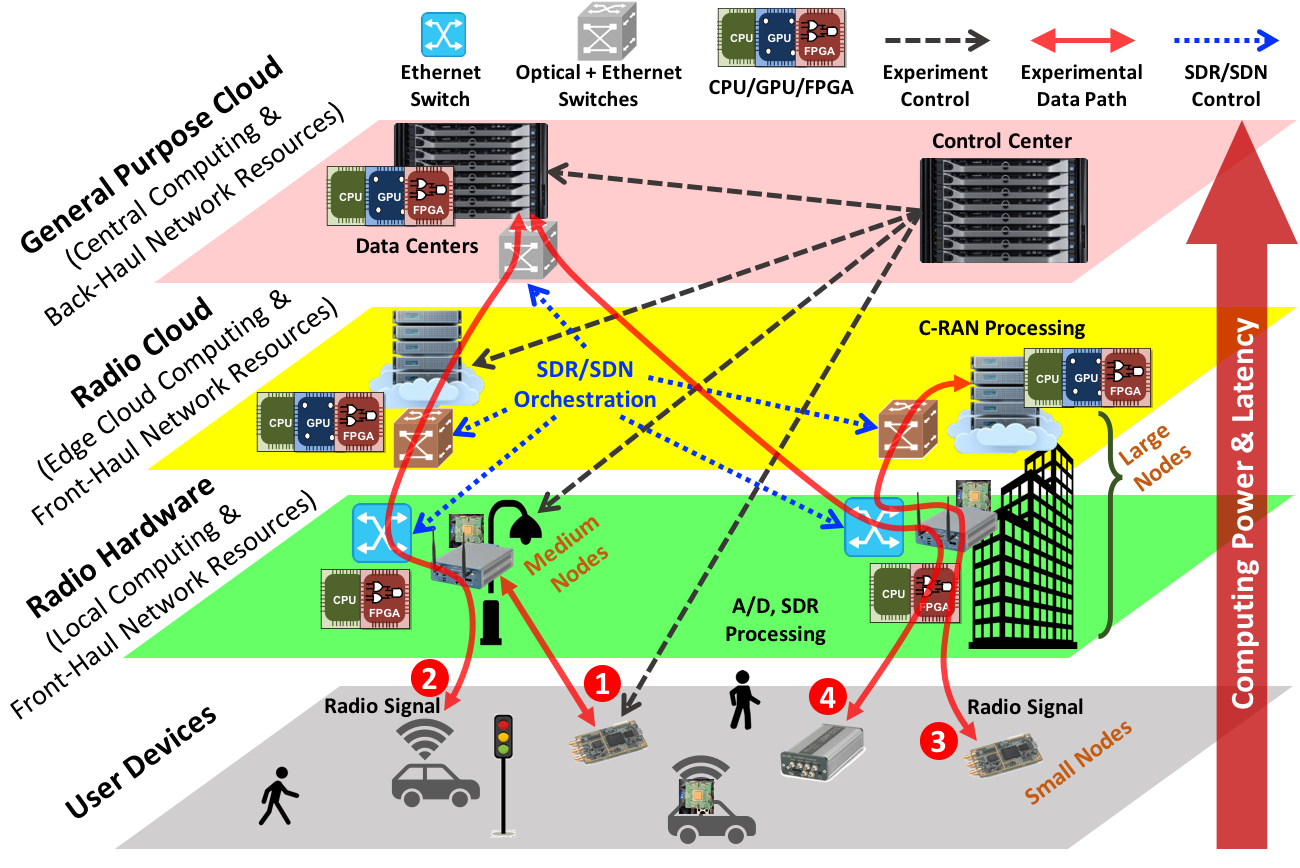
Technology
The COSMOS platform’s technical architecture is designed to meet both quantitative and qualitative requirements associated with a fully programmable city-scale shared multiuser advanced wireless testbed facility. In addition to realizing Gbps+ radio speeds with low latency, the design should support a number of capabilities including remote multiuser access, virtualization of resources, open programmability, flexible topology, node mobility, diversity of radio environments, reproducibility, usability, instrumentation, extensibility and interoperability. Perhaps the most important design consideration is that of open APIs and full programmability across all the technology components and protocol layers. Our approach to realizing full programmability is based on a multi-level SDR and network architecture in which signal and protocol processing functions can be flexibly placed at radio nodes, edge cloud resources or general purpose cloud servers depending on the desired functionality. The testbed’s focus on ultra-high bandwidth wireless implies the need for significant SDR computing capability in the radio access network – rather than placing all the compute functionality at the radio node, having a second layer of “cloud RAN” capability makes it possible to offload a significant part of the node’s function to an infrastructure-based computing cluster. The same edge cloud can be used for network and application level processing particularly in scenarios requiring low latency end to-end response.
The COSMOS testbed poses additional design challenges due to new requirements including wideband radio signal processing (with bandwidths of ~500 MHz or more), support for mmWave communication (28 or 60 GHz), technical challenges of effectively virtualizing radio resources, low latency front- and back-haul, tightly coupled edge cloud and real-world deployment. Many of these issues can be addressed architecturally by building COSMOS as a multi-layered computing system (see Fig. 1) with an RF thin client that can flexibly partition signal processing and network function virtualization (NFV) between a local SDR (with FPGA assist) and a remote cloud radio access network (CRAN) with massive CPU/GPU and FPGA assist. Further, these two SDR computing layers are backed up by a third layer of general purpose cloud computing useful for network and application level functions associated with an experiment.

In terms of technology, radio nodes in COSMOS provide a mix of fully programmable SDRs for flexible wireless experimentation as well as commercial hardware capable of supporting networking and applications research with currently available end-user devices. Following the ORBIT’s open API philosophy, COSMOS is built in a bottom-up manner with commodity components and customized open-source hardware and software modules. The developed wireless platforms cover the full range of spectrum including the sub 6 GHz bands used for today’s services as well as emerging 28 GHz and 60 GHz mmWave bands. In addition to fully programmable radios, COSMOS allows incorporation of state-of-the-art COTS equipment (e.g., the best available 5G or 802.11ad) in order to enable a base service layer that can be used for networking or applications research and for general control and communications needs.
The COSMOS system will also incorporate fast programmable core network technology to keep pace with significant increases wireless link bandwidth and to effectively integrate emerging radio access networks with edge cloud computing. The proposed design includes novel 100 Gbps+ fiber, free space optical, and microwave backhaul technologies interconnected with a software-defined network (SDN) switching fabric for minimum latency and flexibility in setting up experimental network topologies. Sub-microsecond speed optical switching technology will offer the option of passive WDM switch fabrics and radio over fiber interfaces for the purpose of achieving ultra-low latency connections to edge computing services, which will be built in as an integral part of the system. Edge cloud technology to be integrated into the COSMOS system includes commodity CPU + GPU hardware along with FPGA-based co-processors in order to achieve processing speeds necessary to support CRAN, virtualized network functions, and low-latency cloud application scenarios. Another key technology for a successful testbed is the control and management framework which supports experiment setup, resource assignment, orchestration and measurements. The ORBIT Management Framework (OMF) along with selected control elements from GENI and CloudLab provide a proven control software baseline which can be leveraged and extended for use in this project.
[1] D. Raychaudhuri, I. Seskar, G. Zussman, T. Korakis, D. Kilper, T. Chen, J. Kolodziejski, M. Sherman, Z. Kostic, X. Gu, H. Krishnaswamy, S. Maheshwari, P. Skrimponis, and C. Gutterman, “Challenge: COSMOS: A city-scale programmable testbed for experimentation with advanced wireless,” in Proc. ACM MobiCom’20, 2020. [download] [presentation] [long video] [short video]
